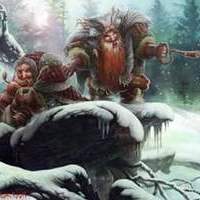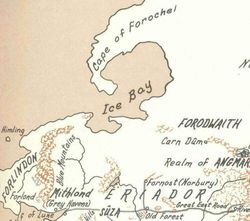A Guide to Races:
Dwarves

Stiffbeards, or Thulin's Folk, are the fifth tribe, or house of the Khazad, (dwarves). As their name suggests, they live in the icy wastes of Forodwaith. They are are also known as Frost Dwarves, Glacier Dwarves, Ice Dwarves or Snow Dwarves.
Culture
Their culture is very much influenced by their environment, which has forged them into a hardy, stoic and hardworking people. Like their cousins of warmer climes, they are master-craftsmen, but do not work with metals. Instead, they work with animal-hide, stone and bone to create their crafts. They make a living by hunting the wild beasts of the north, and have learnt to train rekikoirat, a hardy breed of sled dog resembling wolves in appearance. In addition to hunting, they have also taken to herding feithan, (reindeer/caribou), saiga antelope and the great norsu, (a thick-furred northern relative of the southern oliphaunt.).
Stiffbeards do not value metals, gold, gems and mithril in the same way as the other dwarven houses do, as they have little use for it. Instead, they value the ivory of the norsu, the hide of the winter wyrms, (a flight-less cold drake that stalk the icy wastes), and the teeth of the kalpa-kita, (a great spotted furred sabre-tooth cat.)
In addition to the language, Khuzdul, they also use runes they call felakmek, which they carve into objects they value. The icy wastes hold more dangers to the Stiffbeards than just the bitter cold - ice bears, wolverines, winter bears, wargs, and peikko, (a white-furred snow creature similar to a yeti) also pose a danger. The creatures that are hunted, such as the snow elk, aurochs, deer and ox do not take kindly to it and more than one Stiffbeard have met their demise at the hooves, antlers and horns of these creatures.
The Stiffbeards do not really have a written tradition - their lifestyle and the environment in which they live make it almost impossible to keep them, so instead they have an oral tradition for their stories, knowledge and history. As such, very little is known of their history outside of their own people, and any records found in libraries are likely to be sparse, be inaccurate, or have details missing. Stiffbeards are also an enigmatic folk, and aside from their friendships with the Lossoth, rarely engage with peoples outside of their own folk. Their deeds are only known outside of their own folk when they are drawn into a conflict from outside the region and this occurs rarely. Much of their art, songs, and tales is heavily influenced by their environment, invoking the clarity and coldness of the landscape, the dichotomy of the seasons, for the sun does not set at the height of summer, or rise in the dark of winter, and the mysterious and mesmerizing lights in the night sky.
In appearance, Stiffbeards are taller than most dwarves, having a height of 4 - 5 feet, (1.2 - 1.5m) and are less stocky, having a weight of 130 - 160lb (59 - 72kg). Their hair and beard colours are usually grey, white, blond or red, and their skin is always pale. Like the other tribes, they take pride in their beards and wear theirs long, and pointed. They do not wear metal, because it would harm their skin in the extreme cold of their home, but instead have taken to wearing heavy furs and leathers made from the hides of the animals they hunt or slaughter from their herds. Any jewellery, beads or ornamentation that they wear is expertly carved from wood or bone and bound with sinew.
History:
The father of the Stiffbeards, Thulin awoke in Kheledkhizdin, (also called the Mirror Halls) in the mountain range called the Spine of Arda that lies in the north, beyond the Iron Hills and north of the Sea of Rhun sometime during the Years of the Trees after the awakening of the elves. With him, was Thelor, the father of the Ironfists and the two dwarrowdams who would become the mothers of the tribes. Because they awoke together, Thulin and Thelor each considered the other their brother and they attempted to make Kheledkhizdin their home. At first, they lived along side each other in relative peace, but as their people grew in number, disagreements on governance and how to live began a rift between them.
Melkor, seeking those whom he could corrupt and turn against Eru and the Valar, found the Stiffbeards and the Ironfists and used the discord that had already begun to show between the two groups to his advantage, which eventually resulted in a bitter war between them. The Stiffbeards were harder for Melkor to corrupt and remained loyal to Aule. Later, during the reign of Thelor II, king of the Ironfists, the Ironfists fought on Melkor's side at the Battle of Palisor, and it was this event that led to the break up of the Stiffbeards and the Ironfists. This war had a terrible effect on the Stiffbeards, even though their king tried to keep his people out of the conflict. Disgusted by the actions of Thelor II, along with a need to save his people from further harm, Thulin II abandoned Kheledkhizdin and took his people into Ered Engrin (the Iron Mountains) where he established Kibil-Tarag. The rift between the Stiffbeards and the Ironfists could not be mended easily.
Once they had settled, the Stiffbeards began a friendship with the people that would become the Lossoth, and the two groups assisted each other in matters of survival, including procuring food, shelter, sharing resources and knowledge and defending each other against the dangers of the north.
Change came for the Stiffbeards in the reign of Riimukasi, sometime before the year 2700 of the Second Age, when Sauron began forging the Rings of Power. Under the guise of a servant of Aule, (and something which was easy for Sauron to imitate, as he had once been a servant of Aule before he was corrupted by Melkor), he visited Riimukasi and gave him the Ring, deceiving the dwarf into believing that it was a gift from Aule, which he passed on to his heirs.
In 3319 of the Second Age, the Stiffbeards suffered greatly during the Great Cataclysm, an event triggered by the Numenoreans when they attempted to invade Aman. Thulin V was killed and Kibil-Tarag was largely destroyed, causing the Stiffbeards to abandon it and become more nomadic.
Between 3429 and 3441 of the Second Age, the Stiffbeards came into conflict with the Ironfists again during Surmataja's reign, during the War of the Last Alliance. The Stiffbeards, though still recovering from the disaster that afflicted Kibil-Tarag, did send some dwarves to fight on the side of the Elves and Men against Sauron, and became aware of the Ironfist's second great betrayal and much of their part in the war involved conflict with their estranged kin.
In the later years of Thulin VI's reign, the Stiffbeards had some contact with refugees from Arthedain after they fled to Forochel after the Battle of Battle of Fornost in 1975 of the Third Age. There were some skirmishes with the men of Angmar fighting for the Witch-King during this time.
The Stiffbeard's Ring of Power was lost when the dragons of Forodwaith began a war with the dwarves during the years 2570 - 2589 of the Third Age. Once again, the Stiffbeards suffered heavy loses, this time because they lived very close to the dragons' strong-hold. By this time, the Stiffbeards had suffered numerous catastrophes and their people dwindled in numbers. However, despite this, honour and loyalty are still important to these dwarves and they answered the call of King Thrain II to avenge the death of King Thror, beginning the War with the Orcs between 2793 -2799 of the Third Age.
Kings of Thulin's Line
- Thulin I - Led his people after his awakening in the Years of the Trees, around the same time as the awakening of Thelor I.
- Thulin II - After the Battle of Palisor, in the early First Age, he leads his people from Kheledkhizdin to Kibil-Tarag in the Iron Mountains.
- Thulin III - Established friendship with the Lossoth.
- Bavor
- Riimukasi - Given the ring of Power, sometime before 2700 of the Second Age.
- Bahadur
- Thulin IV
- Thulin V - Died during the great earthquakes that separated Kibil-Tarag from the mainland, during the Great Cataclysm, or Change of the World from being flat to a sphere, around the year, S.A. 3319.
- Surmataja - The Last Alliance of Elves and Men and the War with Sauron takes place during his reign.
- Relin I
- Relin II
- Glorin
- Dolin
- Thulin VI - Lived around 1700 of the Third Age. By this time, the Stiffbeards had become nomads of the Forodwaith, and were a shadow of their former selves.
- Jaasilma - The last of the Stiffbeard kings to carry the Ring of Power given to the Stiffbeards. He died during the War of the Dwarves and Dragons between TA 2570 - TA 2589, after being devoured (while still wearing the Ring), by a dragon.
- Thulin VII
Dwarfholds:

- Akgundim
- Buzan
- Gamil-nala
- Kheledh-dum
- Kheledkhizdin - The awakening place of the Stiffbeards and Ironfists.
- Khibil-Tarag
- Murthunin
- Zigilgund